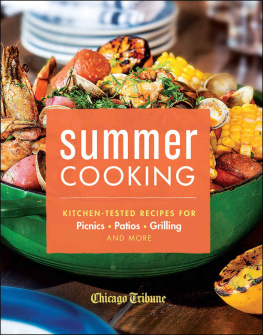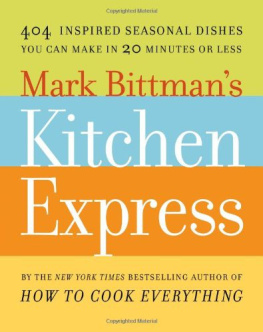
Copyright 2011 by Andrea Reusing
Photographs copyright 2011 by John Kernick
All rights reserved.
Published in the United States by Clarkson Potter/Publishers, an imprint of the Crown Publishing Group, a division of Random House, Inc., New York.
www.crownpublishing.com
www.clarksonpotter.com
CLARKSON POTTER is a trademark and POTTER with colophon is a registered trademark of Random House, Inc.
Library of Congress Cataloging-in-Publication Data
Reusing, Andrea.
Cooking in the moment / Andrea Reusing. 1st ed.
p. cm.
Includes index.
1. Cookery (Natural foods). 2. Menus. I. Title.
TX741.R49 2010
641.5636dc22 2010018532
eISBN: 978-0-307-88974-4
Cover design by Marysarah Quinn
Cover photographs by John Kernick
v3.1
For Mac, Oona, and Arthur


contents

INTRODUCTION
At work, I am a cook first, but in the rest of my life I am an eater. My strongest childhood memories involve food: going to Chinatown in Manhattan for Peking duck before a Yankees game, eating smoky Lebanon baloney at Lancasters Central Market, hearing the rousing anthem our mom still sings as she reveals a surprise box of ice cream sandwiches after dinner. One of my earliest recollections is of my grandmother Marie taking a pot pie big enough to feed twenty-five people out of her oven and resting it on the open oven door for a moment while she grabbed another mitt. It slid off the door and flipped neatly onto the floor. Following my cousin Terrys lead, we took turns kneeling down next to the heap of steaming pie and served ourselves a plate, the desire to comfort Marie nearly as great as our hunger for her pot pie. Food is love, and while dieticians warn us not to confuse the two, how can we help it?
Arriving home for lunch one day from grade school a few minutes before my mom, I ran to the house next door, complaining of extreme, possibly dangerous hunger. Mrs. Galliers got out a big cast-iron skillet and made grilled cheese sandwiches of the old school, with four neat pats of butter (on each side), and then sent me back across the driveway with a tin of pecan sandies. Every day after that, I ran home from school, hoping to slip past my mom so I could ring the Galliers doorbell for further introduction to flavors never before seen in our whole-wheat household: soft Bibb lettuce with green goddess dressing, rare prime rib, and fresh coconut cake. I still think about the chocolate cream pie Mrs. Galliers served my brother, Tim, and me for dessert when we slept over at their house the night our brother Brendan was born.
Always hungry, eventually I had to learn to feed myself. The first things I tried cooking when I left home were the dishes I grew up with: my moms scalloped potatoes and ham, the fried rice my parents made together from Virginia Lee and Craig Claibornes Chinese Cookbook, Maries apple dumplings with cold heavy cream. Most of the friendships I made as a new adult happened around my wobbly dinner table or in restaurants tasting pierogies and kimchi for the first time.
When I left New York for North Carolina in 1996, I worried about the adjustment to living in a small Southern town. The not-quite-a-joke among friends was that my biggest challenge would be leaving the grocery stores and restaurants of the city; theyd imagine me losing my mind in the produce aisle when told that there was no Swiss chard.
Its true that I wasnt ready for my new life. In the beginning, I didnt get that the word yankee could be more descriptive than pejorative. I honked my horn. Twenty-seven years old, I shuddered when called maam and couldnt sit through a basketball game. In line at the hardware store, I grumbled waiting through the inevitable good-byes. During a plumbing disaster at our rural farmhouse, I learned where (and what) the septic tank was.
It turns out I was as clueless about food as I had been about plumbing. The Carrboro farmers market, opened in 1978, was flourishing. There, I could buy German Johnson and Cherokee Purple tomatoes with more personality than any variety I had ever eaten growing up in New Jersey, field peas, fresh goat cheese from Celebrity Dairy, and yes, Swiss chard. Within just a few years, farms here were selling chickens that had been raised outdoors, heritage pork that had been bred for flavor, milk and cheese from grass-fed cows. The selection at my old seafood market had seemed exhaustive, but at Tom Robinsons seafood market I could get meaty black drum; porgies; enlightening versions of favorites like squid, tiny and still in their sparkling purple skins; and soft-shell crabs that had been swimming the night before. Butcher Cliff Collins, in business since 1973, cured his own bacon and was willing to teach me the fundamentals of hog butchery whenever I showed up at his back door with a whole pig. Tiendas and tacquerias were opening, bringing life to formerly foodless blocks with fresh produce and homemade tortillas. At the coffee shop, you could overhear two medical students ignoring their studies to discuss crop rotation. I had moved to a place where the most coveted seat for dinner was not at a restaurant, but at a farmers potluck.

Living here, eating food from close to homeat friends tables, in restaurants, and in my own kitchenclarified the idea that most delicious and memorable things to eat are real foods: fresh farm eggs, soft-boiled on toast; pan-roasted clams, just out of the water; a perfect, ripe tomato, sprinkled with salt. Cooking became less about what flavors I could scheme to combine or track down and more about what was already here.
Before moving south, I would have viewed a mostly local diet as a limitation; but when I started to reimagine seasonality as a shopping list, the result was freeing. I think of cooking in the moment as focusing on one meal at a timean icy, spicy cucumber soup on an August night, a glass of tangerine juice on a frosty morning, or soft, braised shortribs with horseradish on a gray fall day. Cooking and eating in the moment allows food in season to become a reason for celebrationa Friday-night dinner made entirely from the first CSA share in spring; a whole week of fresh-picked every day; a blue-moon autumn aspara-gus harvest; a rich stew made with the last few sweet potatoes of winter.
This book is a year of cooking from spring through winter for friends and family at home using mostly ingredients from nearby. Many of the recipes included here are impromptu, some are from friends, and one is cribbed from Girl Scout camp. The recipes are a mix of childhood favorites, standbys that can be prepared quickly, simple restaurant dishes, and celebration dishes to feed a crowd. Some are so simple that they dont really qualify as recipes, and that is the point. While I couldnt ignore some regional treats (like ramps, figs, and wild shrimp), most of the ingredients used in the recipes are basics available nearly everywhere, when in season. And while the action takes place here in North Carolina, the kinds of producers and artisans featuredfarmers, ranchers, cheese makers, fishmongers, butchers, and bakerswork and live almost everywhere, producing the flavors that we crave.



















